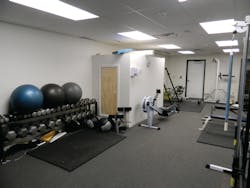Firefighter Fitness: The Safety Triad: Reducing Risk in the Exercise Room - Part 1
The topic of safety in the fire service often conveys thoughts of reflective vests, chevrons on the back of apparatus, the “two-in/two-out” rule and so on. One area of the fire service, or maybe even your firehouse, where safety could be overlooked is the exercise room. Why?
It is easy to forgo the minute details of safety when focused on your workout, when time is limited or when your workout is interrupted. And there isn’t much thought of it after your workout. There are only so many hours in the day, right? If your members never set foot in the exercise room, should they even care about the safety aspects? In short, yes. Safety measures taken – or ignored – by members in the exercise room can affect colleagues, themselves and even family members. In this series, we’ll show you how as we explain the Safety Triad.
Safety considerations
From my experience working in and managing health clubs as well as witnessing what happens in firehouse exercise rooms, I developed a series of safety considerations. As I was compiling the list, the specific tasks or mindsets seemed to fall into three general categories: coaching, education and supervision. Coaching involves an assessment, progression model, training and mentoring. Education covers organizational issues, infection control, orientation and program implementation. Supervision includes maintenance, occupational worries, environmental issues and compliance. Future columns will define these variables.
As with most safety issues, a change in attitude, actions, habits and ultimately culture (group change) is necessary to run a successful exercise room while limiting injuries and improving efficiency. As fitness remains a budgetary item, the last thing we want to show our financial overseers is an exercise room costing the municipality/department money because of injuries from trips, falls, poor form or blood-borne pathogens. Safety is a necessary part of exercise room management.
As you read through the Safety Triad, you may be doing some of these things already. In that case, great work. If not, hopefully these columns will open eyes and prompt just a little bit more action to keep your members safe.
As I mentioned earlier, the potential of disease transmission exists in the exercise room that your members can transfer to colleagues or even bring home to family and friends. Implementing some or all of these safety aspects now can ensure a clean workout environment, especially when the majority of your members are using the room. Even though the risk increases at that point, hopefully the culture fosters safety and hygiene.
If you have a specific question regarding fitness or would like to see a certain topic covered in future column, send an email to [email protected]. Enjoy the series and stay safe!
RICH MEYER is a Certified Strength and Conditioning Specialist (CSCS) and the creator of F.A.S.T. Responders and Iron Jakes firefighter fitness programs. Meyer is a firefighter for Nashua, NH, Fire Rescue and a New Hampshire-certified instructor. His website is www.responsefitness.com
About the Author

Rich Meyer
RICH MEYER is a Certified Strength and Conditioning Specialist (CSCS) and the creator of F.A.S.T. Responders and Iron Jakes firefighter fitness programs. Meyer is a firefighter for Nashua, NH, Fire Rescue and a New Hampshire-certified instructor. His website is www.responsefitness.com
